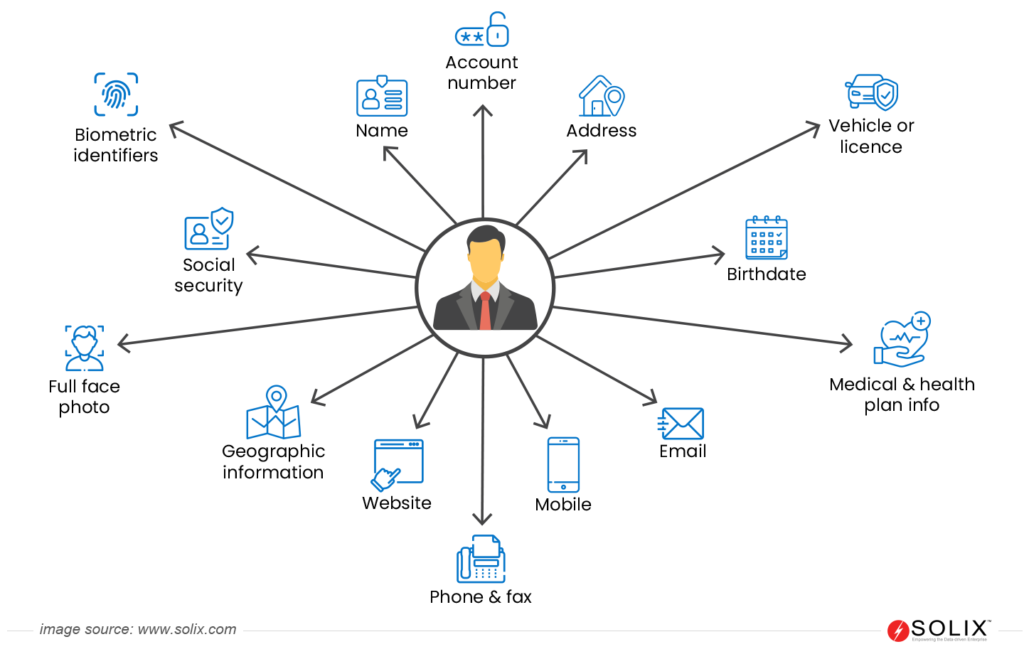Personally Identifiable Information PII
What is Personally Identifiable Information (PII)?
Personal Identifiable Information (PII) is information that can be used to identify a specific individual. It includes data that, on its own or when combined with other information, enables the identification of a person. Examples: Names, Addresses, Phone Numbers, Email Addresses, Social Security Numbers, Passport Numbers, Driver’s License Numbers, Government-Issued IDs (Tax IDs), Birthdate, Race, Birthplace, etc.

Types of PII
Personally Identifiable Information (PII) encompasses various types of data that can be used to identify an individual. Here are some common PII:
Personal Identifiers:
- Full name
- Date of birth
- Social security number
- Passport number
- Driver’s license number, etc
Contact Information:
- Address (home or work)
- Phone numbers (mobile or landline)
- Email addresses, etc
Financial Information:
- Bank account details
- Credit card numbers
- Financial transaction history, etc
Biometric Data:
- Fingerprints
- Retina scans
- Facial recognition data, etc
Health-related Information:
- Medical records
- Health insurance information
- Prescription details, etc
Online Identifiers:
- Usernames
- Passwords
- IP addresses
- Social media profiles, etc
Employment Information:
- Employee ID numbers
- Work-related contact details
- Job title and responsibilities, etc
Education Records:
- Student ID numbers
- Academic transcripts
- Degrees and certifications, etc
Vehicle Information:
- Vehicle registration details
- Driver’s license plate number, etc
Demographic Information:
- Gender
- Race or ethnicity
- Marital status, etc
It’s important to note that the definition and scope of PII may vary based on legal and regulatory frameworks in different regions. Organizations must be aware of the types of PII they handle and take appropriate measures to protect this sensitive information from unauthorized access and breaches. Data masking, encryption, and other security measures are crucial in ensuring the confidentiality and privacy of Personally Identifiable Information.
Understanding personally identifiable information (PII) is crucial in today’s data-driven landscape. From names and addresses to social security numbers, PII encompasses a wide array of data that can uniquely identify individuals. Safeguarding PII is paramount to protect privacy and prevent identity theft. Organizations can uphold trust and integrity in handling sensitive information by implementing robust security measures and adhering to data protection regulations.
FAQ
What qualifies as Personally Identifiable Information (PII)?
PII includes any data that can be used to identify, locate, or contact an individual, alone or in combination with other information. This encompasses names, phone numbers, email addresses, social security numbers, and biometric data.
How does PII differ from non-personally identifiable information?
Unlike non-personally identifiable information (non-PII), which cannot identify specific individuals, PII directly or indirectly identifies individuals and carries higher privacy risks. Non-PII may include anonymized or aggregated data that does not reveal personal identities.
What are examples of indirect identifiers that constitute PII?
Indirect identifiers include data points that can indirectly identify individuals when combined with other information. Examples include demographic details, transaction records, IP addresses, device identifiers, and online browsing history linked to specific individuals.
What measures can I take to protect PII?
Organizations employ various security measures such as encryption, access controls, data masking, regular audits, and compliance with security standards (e.g., ISO 27001) to protect PII from unauthorized access, disclosure, alteration, or destruction throughout its lifecycle.





